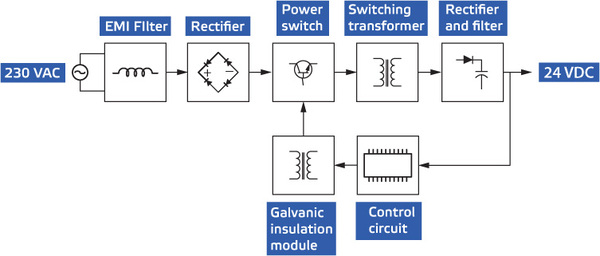Switch mode power supplies - 24 VDC
Switching power supplies, also known as switch-mode power supplies (SMPS) offer higher efficiency, smaller size, and lighter weight making them a preferred choice in electronics and industrial equipment applications.
The fundamental working principle involves rapidly switching an electronic switch on and off at a high frequency. This action generates a square wave-like signal, which, when passed through an inductor and/or transformer, allows for the regulation and transformation of the output voltage to the desired level. The control of the duty cycle, representing the ratio of on-time to off-time in the switching signal, enables precise regulation.
While the input to a switching mode power supply is typically AC (alternating current), the output is usually DC (direct current). The SMPS performs the necessary conversions to ensure stable and efficient output voltage suitable for powering electronic devices that commonly require DC power.


Sentera’s switch-mode power supply modules convert the mains (input) alternating current of 85 - 264 VAC to 24 VDC to supply various devices such as Sentera’s sensors. They provide quite high efficiency of up to 83% and exceptionally low no-load power consumption that is below 0,1 W, thus fulfilling the global regulations on low power consumption for electronics. Also, Sentera’s switching power supplies incorporate EMI filtering components and EMC features to protect against electromagnetic interferences.
Isolated SMPS
Sentera’s switch mode power supplies incorporate electrical isolation between the input and output, allowing for the conversion of electrical energy with minimal risk of electrical shock or damage to connected devices. This safety feature prevents direct electrical contact between the input power source and the output, reducing the risk of electrical hazards.
High efficiency through switching
As implied by their name, the SMPSs are not in a perpetual partially conducting (and henceforth dissipative) mode, but are switched repetitively. The possible states are 2 - the switch is held either ‘ON’ (fully conducting) or ‘OFF’ (fully nonconducting) and nothing in between. While ON, there is (ideally) zero voltage across it, and while OFF we have zero current through it, and this means zero ‘switch dissipation’. Naturally, this is in the “ideal” case scenario since real switches dissipate because the can never neither fully ON nor fully OFF. Even when they are supposedly ON, they have a minor voltage drop across them, and when they are supposedly “OFF,” a minor current still flows through them.
Suitable enclosures
Sentera offers switch-mode power supplies with different IP protection rating and mounting possibilities:
- DIN rail mounted enclosures are designed for mounting electrical equipment in a control cabinet or on a subpanel and provide IP30 rating.
- Industrial enclosures are suited for industrial settings, offering robust protection in demanding environments and provide IP65 rating.
